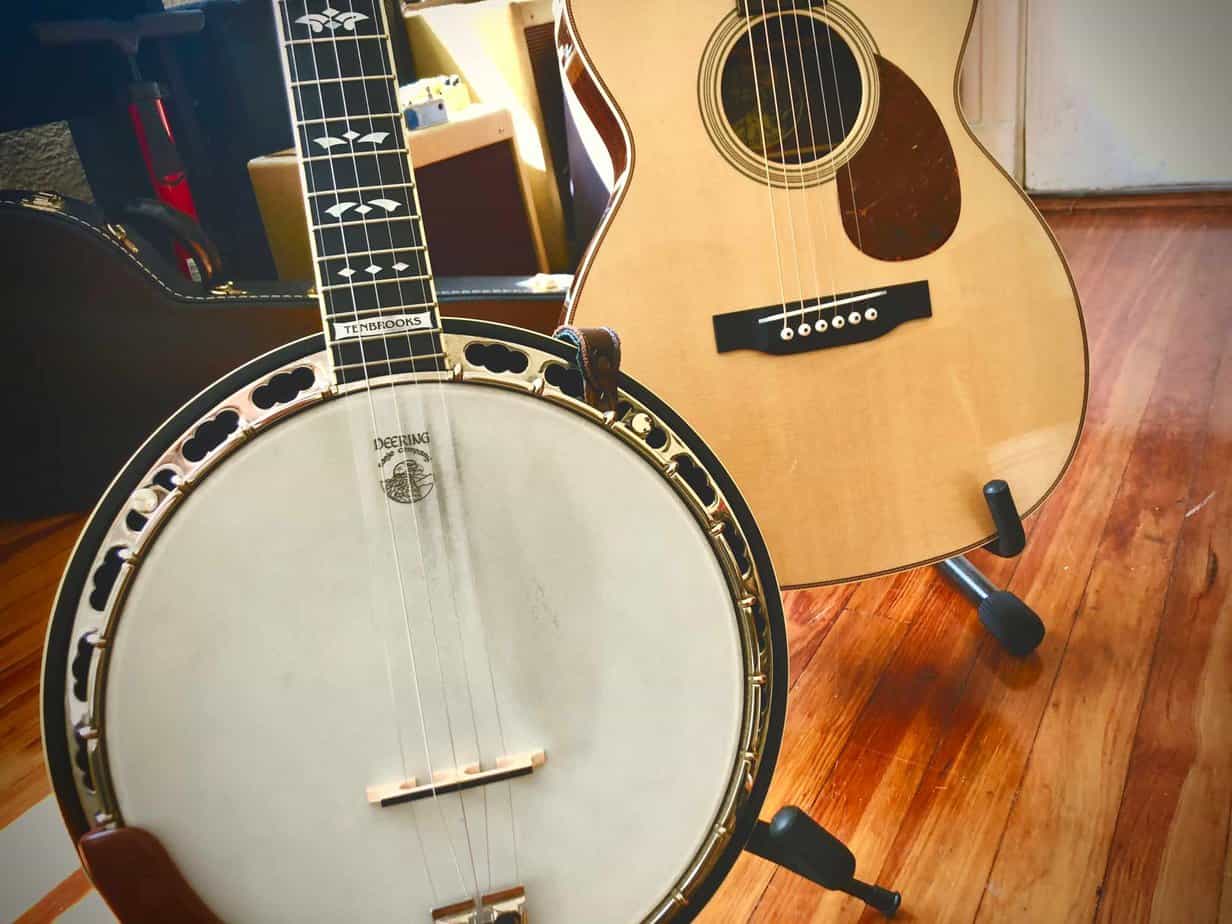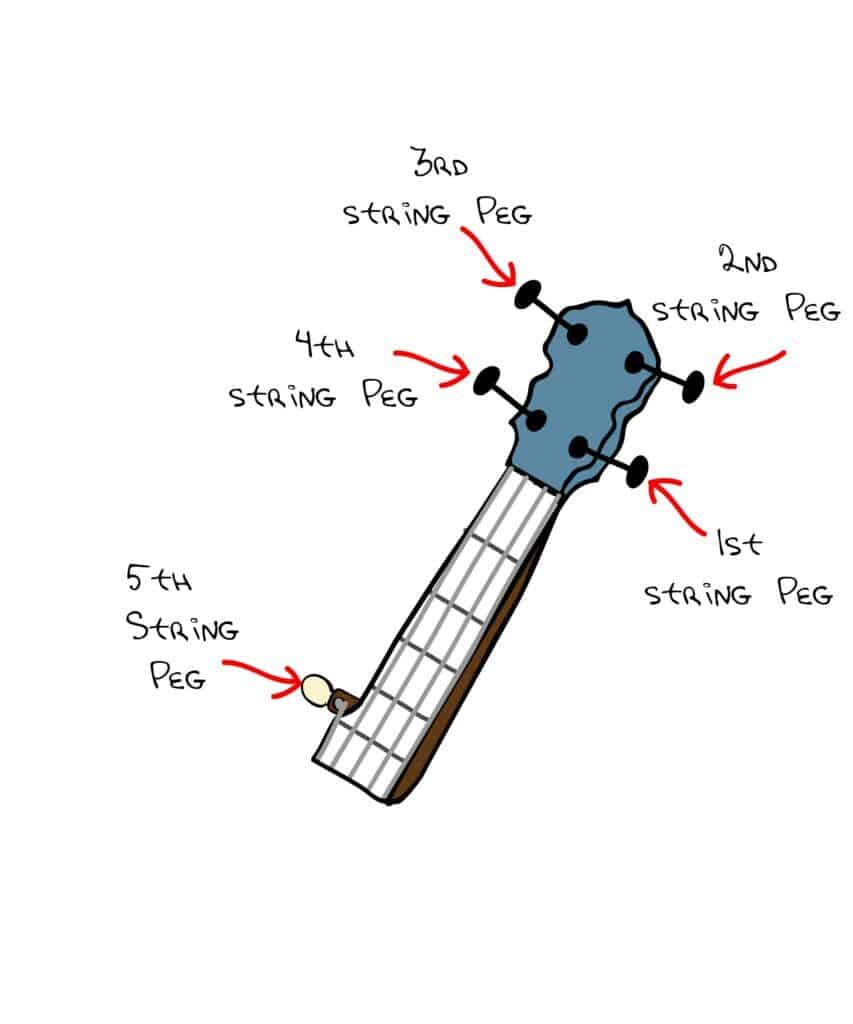As a musician, I’m often asked the question: “What makes a banjo different from a guitar?” After all, both instruments have strings, frets, and are used to create music. Although there are some similarities between the two instruments, there are also some key differences that make the banjo a uniquely different instrument. In this article, I’ll explore what sets the banjo apart from a guitar and how it produces its unique sound.
Types of Banjos
| Types | Description |
|---|---|
| Four-String Banjo | The four-string banjo is the most common type of banjo. It has four strings and is typically tuned to an open G chord. The strings are usually made of metal and the fingerboard is fretted. |
| Five-String Banjo | The five-string banjo is the most popular type of banjo for traditional bluegrass music. It has five strings and is typically tuned to an open G chord. The strings are usually made of metal and the fingerboard is fretted. |
| Six-String Banjo | The six-string banjo is typically tuned to an open G chord, although some players may tune it differently. It has six strings and the strings are usually made of metal and the fingerboard is fretted. |
| Tenor Banjo | The tenor banjo is a four-string banjo that is typically tuned to a GDAE tuning. The strings are usually made of metal and the fingerboard is fretted. |
| Plectrum Banjo | The plectrum banjo is a four-string banjo that is typically tuned to a CGBD tuning. The strings are usually made of metal and the fingerboard is fretted. |
Banjos come in a variety of sizes and styles. The four-string banjo is the most common type, followed by the five-string banjo, which is popular for traditional bluegrass music. There is also the six-string banjo, the tenor banjo and the plectrum banjo. Each type of banjo has its own unique sound and is tuned differently.
Parts of a Banjo
- Neck: The main body of the banjo, typically made of wood and comprising the fretboard, headstock, and tuning pegs.
- Pot: The circular body of the banjo, consisting of a metal hoop and a plastic or wooden rim.
- Head: A drum-like cover that fits over the top of the pot.
- Bridge: A small piece of wood that the strings rest on, transferring their vibrations to the head.
- Tailpiece: A metal device that holds the strings in place.
- Pickups: Electronics that amplify the sound of the banjo.
Strings of a Banjo
- Banjos typically have five or six strings.
- The strings are made of steel or synthetic material.
- The fifth string is a “drone string” that is not fretted. It is most often tuned to a different note than the other strings.
- The four main strings are arranged in pairs, with two strings of the same gauge, but one is tuned higher than the other.
- The higher-pitched string is known as the “melody string”, and the lower-pitched string is called the “rhythm string”.
- The strings of a banjo are usually tuned to open G, open D, open A, and open E.
The strings of a banjo are thinner than those of a guitar and are typically made of steel or synthetic material. Banjos usually have five or six strings, where the fifth string is a “drone string” that is not fretted. It is most often tuned to a different note than the other strings. The four main strings are arranged in pairs, with two strings of the same gauge, but one is tuned higher than the other. The higher-pitched string is known as the “melody string”, and the lower-pitched string is called the “rhythm string”. The strings of a banjo are usually tuned to open G, open D, open A, and open E.
Tuning of a Banjo
Banjos are traditionally tuned to an open G major chord, meaning the strings are tuned to a particular frequency. The head of the banjo is also tuned to a specific tension, which influences the sound of the instrument. The strings of a banjo are typically tuned in fifths, as follows:
| String | Tuning |
|---|---|
| 1st | G |
| 2nd | D |
| 3rd | G |
| 4th | B |
| 5th | D |
The fifth string is commonly replaced with a lighter gauge string, which is then tuned to a higher pitch than the other strings. This string is often referred to as the “drone” string. Tuning a banjo to an open G major chord allows the player to easily play a variety of chords and notes.
Playing Techniques of a Banjo
- Alternating Bass: a technique that requires the player to alternate between strumming the bass string and the other strings with the thumb in a rhythmic pattern.
- Drop Thumb: a technique that involves plucking the bass string with the thumb while strumming the other strings with the index and middle finger.
- Fingerpicking: a technique that requires the player to use the index, middle and ring finger to pluck the strings.
- Hammer-ons: a technique that involves picking a string, then pressing a finger down on another string while the note is still ringing.
- Pull-offs: a technique that involves picking a string, then releasing a finger from the string while the note is still ringing.
- Rolls: a technique that requires the player to roll their fingers over the strings in a rhythmic pattern.
- Slide: a technique that involves sliding up or down the fretboard to create a smooth transition from one note to another.
- Vibrato: a technique that requires the player to rapidly move their finger up and down the fretboard to create a vibrating effect.
The playing techniques of a banjo are quite different from those of a guitar. While guitar players use chords and strumming to create melodies, banjo players use a variety of techniques such as alternating bass, drop thumb, fingerpicking, hammer-ons, pull-offs, rolls, slides, and vibrato to create a unique sound. These techniques can be used to create a range of musical styles, from traditional folk to modern bluegrass.
Difference in Sound between a Banjo and a Guitar
The main difference between a banjo and a guitar is the sound they produce. The banjo produces a more twangy, bright, and ringing sound, while the guitar produces a more mellow, balanced sound. The banjo also tends to be louder than the guitar.
| Banjo | Guitar |
|---|---|
| Twangy, bright, and ringing sound | Mellow, balanced sound |
| Loud | Quieter |
The difference in sound comes from the construction of the instruments. Banjos have a thin, resonant membrane stretched across the top of a drum-like body, while guitars have a hollowed-out body with a solid wooden top. The banjo’s membrane produces a more distinct and sustained sound, while the guitar’s body produces a more mellow sound.
The strings used on each instrument also contribute to the difference in sound. Banjos typically have lighter strings, which produce a brighter sound, while guitars have thicker strings, which produce a richer and more mellow sound.
The type of playing style also affects the sound of the instrument. Banjos are usually played with a picking style, which emphasizes the twangy sound of the instrument, while guitars are usually strummed or fingerpicked, which produces a more balanced sound.
Overall, the sound of a banjo is bright, twangy, and loud, while the sound of a guitar is mellow, balanced, and quieter.
Difference in Size between a Banjo and a Guitar
The difference in size between a banjo and a guitar is quite significant. A guitar typically has a much larger body and neck than a banjo. The body of a guitar can range from 20 to 45 inches in length, while the body of a banjo is typically much shorter, usually measuring between 12 and 15 inches in length. The neck of a guitar is also typically much longer than that of a banjo, and the frets are spaced closer together on a guitar than on a banjo. Additionally, the strings on a guitar are much thicker than those on a banjo. All of these differences in size contribute to the unique sound of each instrument.
History of the Banjo
- The banjo is a stringed instrument with African roots.
- The modern banjo was developed in the early 19th century from African gourd instruments and European lutes.
- The banjo was adapted from a variety of instruments, including the gourd banjo, the minstrel banjo, and the banjo-mandolin.
- The banjo was popularized in the United States in the 19th century by African-American musicians, and it became a central part of American folk and country music.
- In the early 20th century, the banjo was embraced by jazz musicians, and it has since become an integral part of various musical genres including bluegrass, country, rock, and pop.
Frequently Asked Questions
What type of sound does a banjo produce?
Banjos produce a bright, twangy sound that is unique to this instrument. It is characterized by a high-pitched, ringing tone that is created by the combination of the banjo’s strings and the tension of the drumhead. This sound is distinct from the mellow, strummed sound of a guitar, which is produced by the vibration of the strings and the soundboard.
How is the Structure of a Banjo Different from a Guitar?
A banjo has a much shorter neck than a guitar and its strings are spread further apart. It is played using the thumb and fingerpicking techniques, which are different to those used on a guitar. The body of a banjo is usually made from a hollowed-out gourd or metal, while a guitar is usually made from wood. The strings on a banjo are usually made from either metal or nylon and are usually tuned in a higher pitch than a guitar. Finally, a banjo has a drum head on the underside of its body, which creates a unique sound.
What type of playing style is used for a banjo?
Banjo playing consists of a range of techniques, including fingerpicking and strumming. Fingerpicking is used to produce intricate melodies and single-note licks, while strumming plays chords with a flatpick and the fingers. The fingerpicking style used for banjo is similar to other stringed instruments such as the guitar, but uses a thumbpick and one or two fingerpicks.
How does the tuning of a banjo differ from a guitar?
The banjo is tuned differently than the guitar. It is typically tuned to an open G major chord, meaning the strings are tuned to G-D-G-B-D from low to high. This tuning gives the banjo a bright and unique sound. The guitar, on the other hand, is usually tuned to an E major chord, meaning the strings are tuned to E-A-D-G-B-E from low to high. This tuning gives the guitar a fuller, rounder sound.
What are the essential components of a banjo?
A banjo typically consists of a circular body with a membrane stretched over one or both sides, a neck, a string-tensioning mechanism, tuning pegs, and strings. The membrane is usually made of a material such as animal hide, plastic, or metal, and is typically affixed to the body with hooks and bracket hooks. The neck is usually made of wood and contains the tuning pegs, which are used to adjust the tension of the strings. The strings are typically made of steel, nylon, or gut and are strung across the neck and body of the banjo.
Conclusion
The banjo is an instrument with its own unique characteristics that differentiate it from the guitar. From its structure and components to its sound, a banjo is much more than a stringed instrument with a distinct twang. Its distinct sound is a result of its unique construction and materials, including a drum-like body, flexible strings, and a resonator. The banjo is a versatile instrument that can be used in numerous music genres, such as folk, bluegrass, and country. It is also a popular choice among musicians looking to add a unique sound to their performances.







